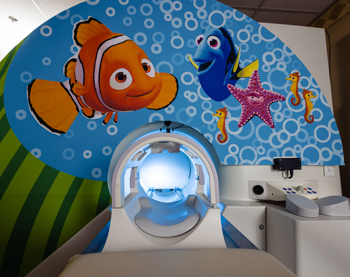Translational Neuroimaging and Neurophysiology

Director: Ed Freedman, Ph.D., Co-Director: Madalina Tivarus, Ph.D.
Objectives
 The Translational Neuroimaging and Neurophysiology (TNN) Core provides UR-IDDRC investigators with priority access to fully modernized high-quality multimodality human and small animal neuroimaging and neurophysiological recording facilities, with a primary emphasis on specialized resources to accommodate measurements in difficult-to-test vulnerable pediatric IDD populations. In addition to next-generation hardware solutions, software and applications, TNN houses technical support staff with a comprehensive array of expertise in the design, implementation, acquisition and analysis of neuroimaging and high-density EEG data. The epicenter of TNN is the Center for Advanced Brain Imaging and Neurophysiology (UR-CABIN), a dedicated 32,000 sq. ft. building. CABIN houses a 3-Tesla state-of-art MRI system (dual transmission, 64 channel receivers, gradient system with maximum amplitude of XR 80 mT/m @ 200 T/m/s) for use with humans and large non-human primates, and a 9.4T small animal multi-nuclei MRI scanner (two gradient/shim systems with maximum amplitude of 660 mT/m @ 4570 T/m/s slew rate) for in-vivo and ex-vivo small rodent imaging; the latter also features a PET insert for simultaneous PET and MR imaging to gain unique insight on structural, molecular and functional processes within a living system at the same time. In addition, there are specialized facilities for ultra-high-density electrophysiology (hd-EEG), high-resolution eye-tracking facilities, mobile brain-body imaging (MoBI), an augmented and virtual reality (AR/VR) facility, 3D morphometric imaging capabilities, and extensive additional support services.
The Translational Neuroimaging and Neurophysiology (TNN) Core provides UR-IDDRC investigators with priority access to fully modernized high-quality multimodality human and small animal neuroimaging and neurophysiological recording facilities, with a primary emphasis on specialized resources to accommodate measurements in difficult-to-test vulnerable pediatric IDD populations. In addition to next-generation hardware solutions, software and applications, TNN houses technical support staff with a comprehensive array of expertise in the design, implementation, acquisition and analysis of neuroimaging and high-density EEG data. The epicenter of TNN is the Center for Advanced Brain Imaging and Neurophysiology (UR-CABIN), a dedicated 32,000 sq. ft. building. CABIN houses a 3-Tesla state-of-art MRI system (dual transmission, 64 channel receivers, gradient system with maximum amplitude of XR 80 mT/m @ 200 T/m/s) for use with humans and large non-human primates, and a 9.4T small animal multi-nuclei MRI scanner (two gradient/shim systems with maximum amplitude of 660 mT/m @ 4570 T/m/s slew rate) for in-vivo and ex-vivo small rodent imaging; the latter also features a PET insert for simultaneous PET and MR imaging to gain unique insight on structural, molecular and functional processes within a living system at the same time. In addition, there are specialized facilities for ultra-high-density electrophysiology (hd-EEG), high-resolution eye-tracking facilities, mobile brain-body imaging (MoBI), an augmented and virtual reality (AR/VR) facility, 3D morphometric imaging capabilities, and extensive additional support services.
Specific aims of the TNN Core include:
- Provide turnkey access to state-of-the-art human and animal neuro-imaging tools optimized to address unique IDD-related experimental needs.
- Provide prioritized access to ultra-high-density electrophysiologic recording facilities, including novel mobile-brain-body-imaging (MoBI) capabilities.
- Make funds available for piloting new MRI/EEG projects.
- Develop a broad, deep and highly accessible repository of data relating to normal development and disease states, in concert with the other IDDRC cores.
- Develop novel data acquisition and analysis methods relevant to IDDRC projects.
How to Access the Core
To initiate an imaging study utilizing the TNN Core, IDDRC investigators are directed to guidelines for creating a proposal that is available on the CABIN website. An essential part of this process is consultation between the PI and a senior faculty member within the TNN Core. The extent of the consultation will vary based on the expertise of the PI in executing imaging and/or EEG studies, but TNN Core faculty are prepared to provide expertise in the design of a proposed study and assessing its feasibility. This process includes identification of any unique needs of a proposal, such as modifications of MR pulse sequences. Imaging provides a sophisticated and diverse palette of phenotyping measures. To maximize the yield from this data, the TNN Core collaborates with the Human Phenotyping and Recruitment (HPR) Core to maintain a comprehensive database of measures acquired on human subjects. Subject to administrative approval, IDDRC members can mine this database with respect to imaging as well as other clinical data.
TNN Core Fee Schedule for Chargebacks | ||
Type of Service | IDDRC Rate | non-IDDRC Rate |
Human 3.0 Tesla MRI | $400/hr | $625/hr |
Human 0.0 Tesla Mock MRI | Free | $40/hr |
MoBI room | $150/hr | $300/hr |
Eye Tracking | Free | $40/hr |
Small animal MRI (operational early 2023) | $150/hr | $300/hr |